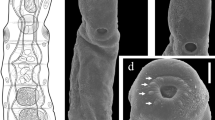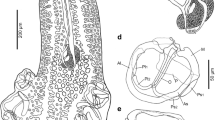Abstract
In this work, we present reisolation and redescription of Balantidium duodeni Stein, 1867 from the European common brown frog Rana temporaria Linnaeus, 1758 using light and electron microscopy. This species has a unique morphological feature—its cells are flattened along the dorsoventral axis. Because of its unique morphology and localization (duodenum) in the gastrointestinal tract of the host, it has been proposed to recognize B. duodeni as a member of separate genus, Balantidiopsis Penard, 1922. Molecular phylogenetic analysis demonstrates it to be close to the type species Balantidium entozoon (Ehrenberg, 1838). We argue that its placement into separate genus is not substantiated. We also propose to reinstate the genus Balantioides Alexeieff, 1931 with the type species Paramecium coli (Malmstein, 1857). The recently proposed generic name for this taxon, Neobalantidium Pomajbíková et al., 2013, is a junior synonym of the previously recognized name.



Similar content being viewed by others
References
Alexeieff A (1931) Sur quelques partcularités de structure de Balantioides (nom. nov.) coli (Malmsten). CR Acad Sci D Nat 11:210–211 (in French)
Bhatia BL (1936) The fauna of British India including Ceylon and Burma. Taylor and Francis, LTD, London. doi:10.5962/bhl.title.47065
Castresana J (2000) Selection of conserved blocks from multiple alignments for their use in phylogenetic analysis. Mol Biol Evol 17:540–552. doi:10.1093/oxfordjournals.molbev.a026334
Darriba D, Taboada GL, Doallo R, Posada D (2012) jModelTest 2: more models, new heuristics and parallel computing. Nat Methods 9:772. doi:10.1038/nmeth.2109
de Puytorac P, Grain J (1965) Structure et ultrastructure de Balantidium xenopi sp. nov. Cilie Trichostome parasite de Batracien Xenopus fraseri. Boul Protistol 1:29–36 (in French)
Edgar RC (2004) MUSCLE: multiple sequence alignment with high accuracy and high throughput. Nucleic Acids Res 32:1792–1797. doi:10.1093/nar/gkh340
Esteban JG, Aguirre C, Angles R, Ash LR, Mas-Coma S (1998) Balantidiasis in Aymara children from the northern Bolivian Altiplano. Am J Trop Med Hyg 59:922–927
Grim JN (1993) Description of somatic kineties and vestibular organization of Balantidium jocularum sp. n., and possible taxonomic implications for the class Litostomatea and the genus Balantidium. Acta Protozool 32:37–45
Grim JN (2006) Food vacuole contents in the ciliate, Balantidium jocularum (Balantididae), a symbiont in the intestine of the surgeonfish, Naso tonganus (Acanthuridae). J Eukaryot Microbiol 53:269–274. doi:10.1111/j.1550-7408.2006.00101.x
Grim JN, Buonanno F (2009) A re-description of the ciliate genus and type species, Balantidium entozoon. Eur J Protistol 45:174–182. doi:10.1016/j.ejop.2008.10.001
Grim JN, Clements KD, Byfield T (2002) New species of Balantidium and Paracichlidotherus (Ciliophora) inhabiting the intestines of four surgeonfish species from the Tuvalu Islands, Pacific Ocean. J Eukaryot Microbiol 49:146–153. doi:10.1111/j.1550-7408.2002.tb00359.x
Guinea A, Anadon R, Fernandezgaliano D (1992) Light and electron microscopic study of Balantidium entozoon (Ciliophora, Vestibuliferida)—somatic cortex and vestibular cavity. Arch Protistenkd 142:41–50. doi:10.1016/S0003-9365(11)80099-0
Hall TA (1999) BioEdit: a user-friendly biological sequence alignment editor and analysis program for Windows 95/98/NT. Nucl Acid S 41:95–98
Ito A, Ishihara M, Imai S (2014) Bozasella gracilis n. sp. (Ciliophora, Entodiniomorphida) from Asian elephant and phylogenetic analysis of entodiniomorphids and vestibuliferids. Eur J Protistol 50:134–152. doi:10.1016/j.ejop.2014.01.003
Jankowski AW (2007) Phylum Ciliophora Doflein, 1901. In: Alimov AF (ed) Protista: Handbook of Zoology, vol 2. Nauka, St. Petersburg, pp 415–993 (in Russian)
Kornilova OA, Chistiakova LV, Yagunova EB (2014) Species of the genus Balantidium from fish and amphibians: morphometric data. Vestn St Petersburg U 3:5–19 (in Russian)
Kostygov AY, Frolov A, Kostygov AY, Frolov AO (2007) Leptomonas jaculum (Leger, 1902) Woodcock 1914: a leptomonas or a blastocrithidia? Parazitologiya 41:126–136 (in Russian)
Li M, Li D, Wang J, Zhang J, Gu Z, Gong X (2007) Light and scanning electron microscopic study of Balantidium ctenopharyngodoni Chen, 1955 (class: Litostomatea) from China. Parasitol Res 101:185–192. doi:10.1007/s00436-006-0451-1
Li M, Wang C, Wang J, Li A, Gong X, Ma H (2009) Redescription of Balantidium polyvacuolum Li, 1963 (class: Litostomatea) inhabiting the intestines of Xenocyprinae fishes in Hubei, China. Parasitol Res 106:177–182. doi:10.1007/s00436-009-1645-0
Li M, Wang C, Wang J, Yu D, Wang W, Ge X, Xu P (2011) PCR amplification, sequencing and analysis of 18S rDNA of Balantidium ctenopharyngodoni inhabiting grass carp. Acta Hydrobiol Sin 35:203–209 (in Chinese)
Li M, Li W, Zhang L, Wang C (2013) Balantidium honghuensis n. sp. (Ciliophora: Trichostomatidae) from the rectum of Rana nigromaculata and R. limnocharis from Honghu Lake, China. Korean J Parasitol 51:427–431. doi:10.3347/kjp.2013.51.4.427
Lynn DH (2008) The ciliated protozoa: characterization, classification, and guide to the literature. Springer, Dordrecht
Maslov DA, Votýpka J, Yurchenko V, Lukeš J (2013) Diversity and phylogeny of insect trypanosomatids: all that is hidden shall be revealed. Trends Parasitol 29:43–52. doi:10.1016/j.pt.2012.11.001
Medlin L, Elwood HJ, Stickel S, Sogin ML (1988) The characterization of enzymatically amplified eukaryotic 16S-like rRNA-coding regions. Gene 71:491–499. doi:10.1016/0378-1119(88)90066-2
Milyutina IA, Aleshin VV, Mikrjukov KA, Kedrova OS, Petrov NB (2001) The unusually long small subunit ribosomal RNA gene found in amitochondriate amoeboflagellate Pelomyxa palustris: its rRNA predicted secondary structure and phylogenetic implication. Gene 272:131–139
Nie D (1935) Intestinal ciliates of Amphibia of Nanking. Contrib Biol Lab Sci Soc China 11:47–95
Nilles-Bije ML, Rivera WL (2010) Ultrastructural and molecular characterization of Balantidium coli isolated in the Philippines. Parasitol Res 106:387–394. doi:10.1007/s00436-009-1673-9
Paulin JJ, Krascheninnikow S (1973) An electron microscopic study of Balantidium caviae. Acta Protozool 12:97–104
Pomajbíková K et al (2013) Novel insights into the genetic diversity of Balantidium and Balantidium-like cyst-forming ciliates. PLoS Neglect Trop Dis 7:e2140. doi:10.1371/journal.pntd.0002140
Ponce-Gordo F, Jimenez-Ruiz E, Martinez-Diaz RA (2008) Tentative identification of the species of Balantidium from ostriches (Struthio camelus) as Balantidium coli-like by analysis of polymorphic DNA. Vet Parasitol 157:41–49. doi:10.1016/j.vetpar.2008.06.024
Ponce-Gordo F, Fonseca-Salamanca F, Martinez-Diaz RA (2011) Genetic heterogeneity in internal transcribed spacer genes of Balantidium coli (Litostomatea, Ciliophora). Protist 162:774–794. doi:10.1016/j.protis.2011.06.008
Schuster FL, Ramirez-Avila L (2008) Current world status of Balantidium coli. Clin Microbiol Rev 21:626–638. doi:10.1128/CMR.00021-08
Schuster FL, Visvesvara GS (2004) Amebae and ciliated protozoa as causal agents of waterborne zoonotic disease. Vet Parasitol 126:91–120. doi:10.1016/j.vetpar.2004.09.019
Senler NG, Yildiz I (2000) The ciliate fauna in the digestive system of Rana ridibunda (Amphibia: Anura) I: Balantidium (Balantidiidae, Trichostomatida). Turk J Zool 24:33–43
Stamatakis A (2014) RAxML version 8: a tool for phylogenetic analysis and post-analysis of large phylogenies. Bioinformatics 30:1312–1313. doi:10.1093/bioinformatics/btu033
Stein F (1867) Der Organismus der Infusionsthiere nach eigenen Forschungen in systematischer Reihenfolge bearbeitet. II. Abtheilung. 1) Darstellung der neuesten Forschungsergebnisse über Bau, Fortpflanzung und Entwickelung der Infusionsthiere. 2) Naturgeschichte der heterotrichen Infusorien. Engelmann, Leipzig (in German)
Sukhanova KM (1960) Cytophysiological characteristics of life cycles of Balantidium ciliates from amphibians. In: Problems of cytology and protistology. Institute of Cytology, Moscow - Leningrad, pp 285–312 (in Russian)
Vd’ačný P, Orsi W, Bourland WA, Shimano S, Epstein SS, Foissner W (2011) Morphological and molecular phylogeny of dileptid and tracheliid ciliates: resolution at the base of the class Litostomatea (Ciliophora, Rhynchostomatia). Eur J Protistol 47:295–313. doi:10.1016/j.ejop.2011.04.006
Votýpka J, Maslov DA, Yurchenko V, Jirků M, Kment P, Lun ZR, Lukeš J (2010) Probing into the diversity of trypanosomatid flagellates parasitizing insect hosts in south-west China reveals both endemism and global dispersal. Mol Phylogenet Evol 54:243–253
Acknowledgments
This work was done with a financial support of the Russian Foundation for Basic Research (12-04-00767-а) using equipment and resources of the Life Science Research Centre (University of Ostrava), Facility Centers “Culturing collections of microorganisms” and “Chromas” (St. Petersburg State University).
Conflict of interest
The authors declare no conflicts of interest.
Author information
Authors and Affiliations
Corresponding author
Rights and permissions
About this article
Cite this article
Chistyakova, L.V., Kostygov, A.Y., Kornilova, O.A. et al. Reisolation and redescription of Balantidium duodeni Stein, 1867 (Litostomatea, Trichostomatia). Parasitol Res 113, 4207–4215 (2014). https://doi.org/10.1007/s00436-014-4096-1
Received:
Accepted:
Published:
Issue Date:
DOI: https://doi.org/10.1007/s00436-014-4096-1




